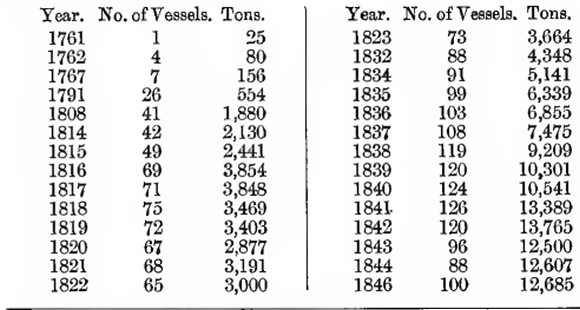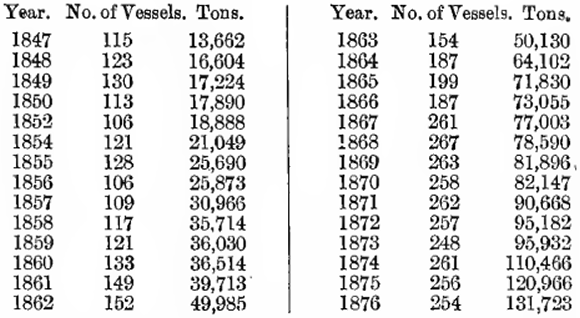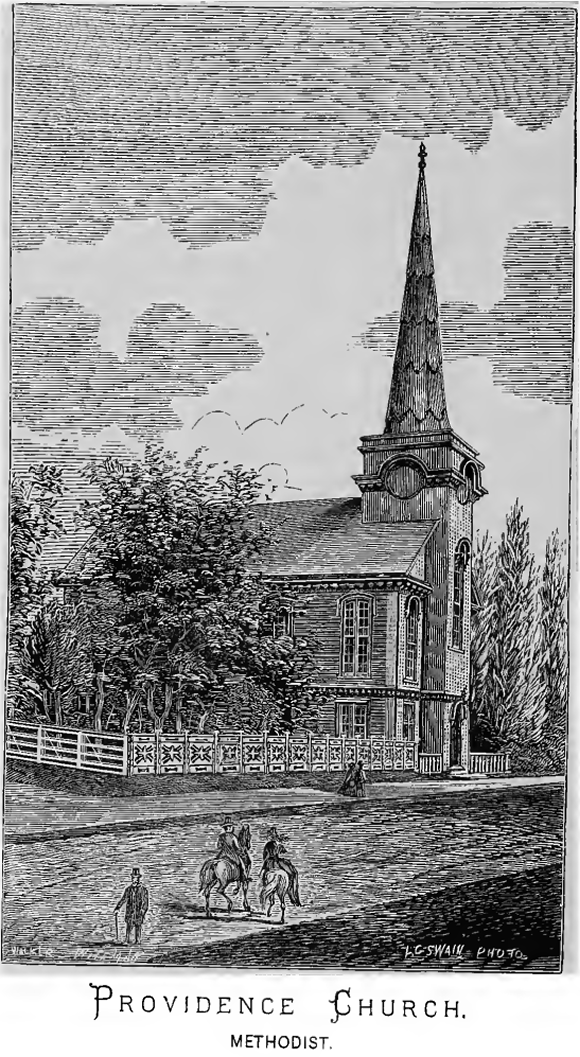|
“Who, in frail barques,
the ocean surge defied
And trained the race that live upon the wave?
What shore so distant where they hare not died?
In every sea they found a watery grave.
Honour, for ever, to the true and brave
Who seaward led their Sons with spirits high,
Bearing the red cross flag their fathers gave;
Long as the billows flout the arching sky
They’ll seaward hear it still, to venture or to die.”
OUR reference to the
loss of vessels connected with this County in the war of 1812-1814,
together with the first visit in 1808 of a man whose early enterprise is
worthy of a public memorial, lead us to
THE HISTORY OF OUR SHIPPING INTERESTS
a subject ever fresh
and interesting, and to some extent an illustration of the saying that
truth is stranger than fiction. The narrative is necessarily one more of
the Township than of the County; and again, in a smaller circle, of the
Town, rather than of the Township.
By a tradition, with which even the children are familiar, in the year
of settlement, there was one Schooner belonging to the party named the
“Pompey.” The 25 tons of 1761 gave place a century later, 1861, to 149
vessels of 89,713 tons. Great as the ratio of this increase is, it pales
before that of the next ten years; for in 1871 the tonnage was upwards
of ninety thousand: equal to the whole of the British shipping in the
time of Henry the Seventh; and equal to the shipping of the port of
London, in the reign of Charles the Second. And great as the increase of
the century ending 1861 was; the fourteen years which have since
elapsed, have served to swell that increase by two hundred per cent. And
should the same ratio be maintained throughout the century ending 1961,
the tonnage will have increased to upwards of 420,000: a presumption
which, with the blessing of heaven, without which, prosperity is an
evil, experience renders reasonable. For this increase has not been
spasmodic; nor has it been characterized by great or retrogressive
fluctuations. With very few exceptions, from the year of settlement down
to the present, every succeeding year shows a marked and steady advance.
There may be traces of the truth of the theory that there is a great
depression every ten years; but, for the more part, progress and
increase is the watchword. In the years 1843-4, there was a falling off
both in numbers and tonnage. But frequently the number of vessels
registered without reference to tbe tonnage would mislead. Thus, in 1839
there were 120 vessels, whose aggregate was 10,000 tons. In 1859, twenty
years afterwards, there were but 123 vessels with a tonnage, however,
amounting to 35,000, showing an increase of only three vessels, hut at
the same time of 25,000 tons. The explanation is, that, in the mean
time, a very different class of vessels had come into existence, engaged
in a very different trade. Before 1820 there were but one or two vessels
which crossed the Atlantic; but by the year 1850, those that left
Yarmouth seldom returned, in the sense of carrying freight to or from
the Port. There is another sense however, in which they never return:
and it is a melancholy fact, the details of which are before us, that up
till the present time there have been 600 vessels lost out of
Yarmouth—in nearly 100 of which there was loss of all hands.
The names of Bobbins, Lovitt, Baker, Byerson, Moses, Killam, Dennis and
Doane, Goudey, Moody, and very many others, tell us of the successful
extension of our foreign shipping interests. But to none of them,
however largely they may have contributed towards the building up and
extending of that department, belongs the honour of having, so to speak,
originated the foreign trade of the Port. That honour belongs to a man
whose name does not appear in our lists— ANTHONY LANDERS, a native of
Sunderland, England, whose spirited and extensive operations in ship
building, merited a more successful issue. Mr. Landers first arrived in
Yarmouth in 1808, on board a Dutch galliott of 101 tons, named the
“Badger,” which he loaded with a cargo of timber for Sunderland. On his
return he bought two grants of land, to facilitate his future
operations. The first vessel he built was a brig of 250 tons named the
“Peter Waldo.” She was launched at Plymouth. He afterwards built another
brig( at Plymouth named the “Bittern,” which he also loaded with timber
for the English market. Oh his return voyage, having on board the
weights and measures for the Township of Yarmouth, together with some of
the best Northumberland sheep, and a Northumberland bull and cow, he was
taken off Halifax by the “Tezel,” an American privateer, belonging to
Providence, R. I. They offered him and his crew the long boat; hut
Captain Landers refused to leave his ship. When the privateer and her
prize arrived at Providence, the authorities received him kindly, but
kept his vessel. He stated his scheme about improving the stock; and
they gave him some of their best breeds, which they afterwards sent to
him at Yarmouth.
When the war was over, he bought an American vessel, which had been
taken by a Liverpool privateer. Her name had been the “Factor,” which he
changed to the “Bittern,” and all that remains of her lies in the
Yarmouth harbour. He sailed some time in this vessel between Yarmouth
and England. In the year 1818 he brought out all his furniture and other
effects, including improved farming implements, together with a
competent man, the late George W. Brown, to carry on the farm.
In 1819 he built the barque “Zebulun,” 300 tons; in 1821 the “Waldo,”
250 tons; the “Thales,” at Tusket, 260 tons; and at Salmon River, the “Ugonia,”
260 tons. In 1825 he built the “Thetis,” 300 tons; and, at Milton, the
barque “Hebron.” In 1830 he built the barque “Dove,” and the brig
“Rhoda,” each 275 tons. If the circumstances be all taken into account,
it must be confessed that he was a far more than ordinarily spirited and
enterprising man: and he may justly, I conceive, be called the Father,
if not the Founder of our foreign trade, which is the main source of the
continued and increasing prosperity of Yarmouth.
But fickle as she is said to be, Fortune was more than usually so with
this man. In the year 1833, he went to reside1 in England; and, I have
heen credibly informed, that a few years ago, a number of Yarmouth men
being in Liverpool, subscribed among them to furnish him with a coat. He
became beggared in the initiating and prosecuting of an enterprise, in
which thousands are now becoming rich. I have transferred from the
Herald,
THE USUALLY RECEIVED LIST OF VESSELS,


which have belonged to
Yarmouth at different periods.
The uncommon prosperity of our people in shipping affairs frequently
excites wonder and enquiry. But in this case, however we may fail to
trace all the
CAUSES OF SUCCESS, there are many which lie upon the surface, plain and
obvious to all who will note them. Besides the traditions of the place,
and impressions dating from early childhood, we may trace the elements
of prosperity in the constant application of the principle of mutual
assistance which holds out encouragement, by promising advancement to
the deserving; a co-operative spirit widely applied to every department
of the business; a practical study of marine law ;3 a close observation
of the most approved methods of ship building, and of conducting
insurance matters; extensive knowledge of foreign ports; personal
acquaintance with the most reliable agents; captains in charge whose
characters are soon well known, and who are interested as part owners;
scrupulous regard to foreign credit; quick intelligence and
unconquerable enterprize; and, above all, the protecting band of an
auspicious Providence, whose blessing accompanies and gives success to
human efforts, and so brings those vessels from time to time unto the
haven where they would be.
As an illustration of tbe tentative maritime spirit of the people, I
think it to the purpose to present the reader with the following extract
from “A Lecture on the Screw Propeller,” delivered before the Yarmouth
Literary Society, 12th January, 1841, by James C. Farish, M. D.:—
“It is now seven years since Mr. John Patch, an ingenious shipwright of
this place, having been long convinced from his observations upon the
means in use for propelling vessels—from an oar to a paddle wheel—that
there might still be something invented more efficient than any of
these, in the spring of 1834 completed a Screw which he had been some
time contriving for that purpose. He was then residing at Kelley’s Cove,
in this County, and was observed for some months to have been privately
engaged at work in the store and in the boats off the wharves. At length
he communicated his secret to Captain Robert Kelley, but not until be
had alone made sufficient trials of his machine. Captain Kelley assisted
him, and they two, by the simple working of a crank, sent their boat
ahead at the rate of five or six knots, without oars or sails.
“During that summer he was sailing up St. John harbour in a little
schooner of twenty-five tons, in company with ten or twelve other
vessels, when it fell dead calm. He got out his Screw over the quarter,
and he and Capt. Silas Kelley (the only persons on board) by the same
simple power, a crank, soon left the rest of the fleet astern, wondering
by what means he had got ahead of them, without sweeps or any other
visible assistance.
“Having perfected his discovery, and made such trials as satisfied
himself and his confidential friends, Mr. Patch in July, 1834, at
Captain R. Kelley’s suggestion, proceeded to Washington to take out a
patent for his invention; but everything that he met with bad the effect
of discouraging him, and at last he abandoned his purpose. As Mr. Patch
spoke freely of his invention, and as the Screw Propeller appeared
within a year or two after this date, it seems reasonable to suppose
that others profited by his labours. If not the original inventor, an
original inventor he certainly was.”
Intimately connected with the matter of Shipping, is that of
COAST AND HARBOUR CONVENIENCES.
Before 1830, there were neither lights nor whistles, beacons nor
breakwaters in the County. In 1820, the Governor in Council was
memoralized to cause the outer Seal Island to be settled, and a light
placed thereon. Nothing was done in that way however, till 1830, in
which year the lighthouse was established. In 1839 the Yarmouth
lighthouse was built, and it was first lighted on the 15th of January,
1840. The bell which had been fixed in the same neighbourhood was
removed for the fog whistle, which was first used in February, 1869.
Since 1870 a whistle has also been placed on the Seal Island ; and those
safeguards, together with the light on Pubnico beach, placed there in
1854; that on the Fish Island in the Tusket River, placed there in 1864;
the beacon in the Yarmouth Harbour lighted on February 16th, 1874;
together with that on White Head Island at the mouth of the Argyle
Harbour, well nigh supply everything except skill and care on the part
of navigators, for the safe conduct of shipping.
Another work of moment to the County ultimately, although to the port
primarily, is the breakwater in the Yarmouth Harbour, a work which was
done in 1873 at a cost of $11,000. It is a substantial work 2,800 feet
long, 22 feet wide, with an average height of seven feet, and is
designed to arrest the strong tendency created by the action of the high
tides and westerly winds, to obstruct, and finally destroy, the Harbour.
It is hard to determine how much is due to the late Anthony Landers; hut
among other things with which he may he credited, is the introduction
and advancement of
THE METHODIST BODY IN THIS COUNTY.

The now thriving
settlement of Hebron was very largely Mr. Landers’ property. He there
built and resided in what he named “Hebron House,” in which he began to
hold meetings in the year 1810; and seven years afterwards he built a
chapel at Hebron, which however was never finished, and which has long
since disappeared. He also procured the services from Conference of the
first Methodist Minister in the County, the Bev. Mr. Alder, a talented
man who died in 1873 in Gibraltar, in which Diocese, in connection with
the Church of England, he had become Registrar and Surrogate. For
several years Mr, Landers hoarded Mr. Alder and paid his expenses. Since
that time the Methodist body has greatly increased. They have four
modern places of worship in the Town and vicinity of Wesley Church at
Milton, which was built about ten years ago, when the society abandoned
their less convenient chapel, which had been used since 1839; Providence
Church in the south end of the Town, which also supplanted an earlier
structure; a smaller building at Arcadia ; and another at Brooklyn. They
have also a fifth place of worship at the thriving settlement at
Darling’s Lake. The reader has here a view of Providence Church which is
situate at the south end of the Town.
In this connection, as a religious matter, the history of the Free
Baptist body may be touched upon. In the year 1819 the Bev. Jacob B.
Norton came to Yarmouth from the State of Massachusetts. He belonged to
the Society known as the Christian Band. About the same time, the Rev.
Asa McGray went to Barrington from the same State. He belonged to the
Freewill Baptist body. They each succeeded in gaining adherents to their
respective Societies. In June, 1837, ministers and delegates of both
bodies met on Cape Sable Island and organized the Free Christian Baptist
Denomination, as an amalgamation of both; and finally, in 1866, this
body agreed to be known by the name of Free Baptists. There are I
believe eleven Free Baptist churches in this County, possessing over a
dozen meeting houses, and served by four resident ministers, besides
occasional assistance.
Closely connected with public worship, is the matter of Sunday Schools.
It is evident that any number of children brought together to be taught
gives the idea of a School; and, that a number of children brought
together to be taught on Sundays, completes the general idea of a Sunday
School. But although it would be impossible to go back to the time in
the Christian era when children were not brought together to be taught
on Sundays, this would hardly be the sense in which that expression has
come to be understood.
After careful and extended enquiries on the subject, I believe that the
first Sunday School proper in this County was opened in Lower Chebogue
by the Rev. Abel Cutler in 1817; Mr. John S. Miller establishing a
similar institution, which was more of the nature of a Prayer Meeting
however, about*%ie same time or a little after, in Nehemiah Patch’s
loft. The next was opened in the old Milton school house, which stood on
the site-of the late Herbert Huntington’s house, about the year 1823.
Then in 1827 another was commenced in the old Methodist Chapel, which
lasted till 1834, when it lapsed. In January of 1835 the Rev. Alfred
Gilpin opened one in the old Trinity Church; an offshoot from which
established itself at Upper Chebogue, now Arcadia, in the fall of the
same year. All those Schools had been conducted on the Union principle:
but, in the month of August, 1836, the Methodist element withdrew from
the Trinity Church school, and formed a denominational school. About the
same time, Mr. Joseph Ellis, who had been prominently concerned with
nearly all those institutions, opened one in his own house: and, shortly
afterwards, another was commenced by the Baptists. After this period,
they continued to spring up everywhere; until now there is no section in
the County where there is not one.
The first structure raised in the County for Sunday School purposes was
that which was erected by the Episcopalians in 1840, and was the same
building which now stands, newly restored, on the site of the old Parish
Church. |
